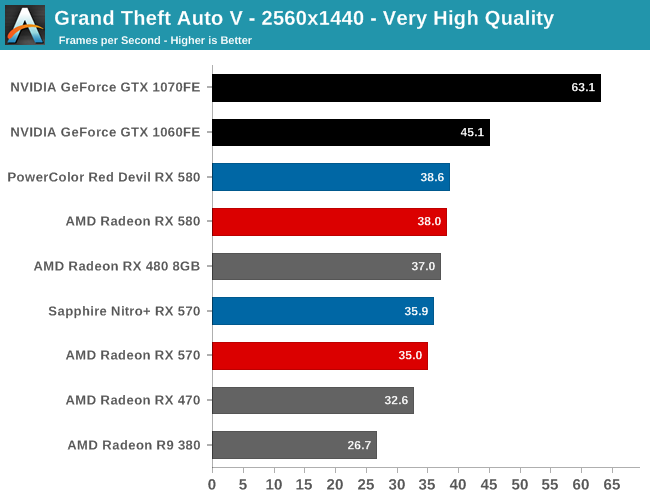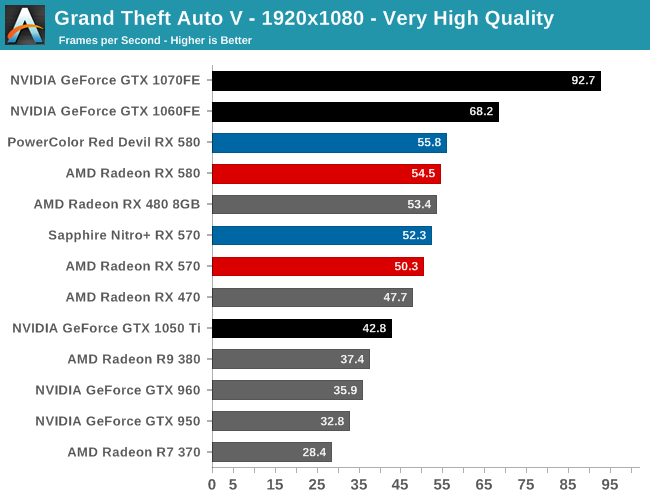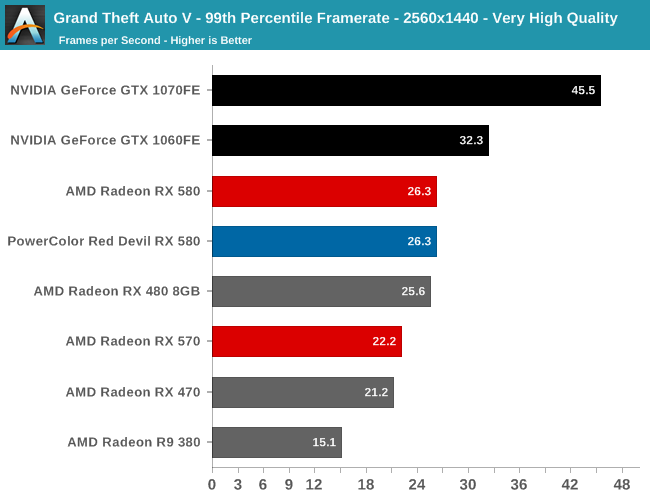The AMD Radeon RX 580 & RX 570 Review: A Second Path to Polaris
by Ryan Smith on April 18, 2017 9:00 AM EST- Posted in
- GPUs
- AMD
- Radeon
- Polaris
- Radeon RX 500
Grand Theft Auto V
The latest edition of Rockstar’s venerable series of open world action games, Grand Theft Auto V was originally released to the last-gen consoles back in 2013. However thanks to a rather significant facelift for the current-gen consoles and PCs, along with the ability to greatly turn up rendering distances and add other features like MSAA and more realistic shadows, the end result is a game that is still among the most stressful of our benchmarks when all of its features are turned up. Furthermore, in a move rather uncharacteristic of most open world action games, Grand Theft Auto also includes a very comprehensive benchmark mode, giving us a great chance to look into the performance of an open world action game.
On a quick note about settings, as Grand Theft Auto V doesn't have pre-defined settings tiers, I want to quickly note what settings we're using. For "Very High" quality we have all of the primary graphics settings turned up to their highest setting, with the exception of grass, which is at its own very high setting. Meanwhile 4x MSAA is enabled for direct views and reflections. This setting also involves turning on some of the advanced redering features - the game's long shadows, high resolution shadows, and high definition flight streaming - but it not increasing the view distance any further.
Otherwise for "High" quality we take the same basic settings but turn off all MSAA, which significantly reduces the GPU rendering and VRAM requirements.














129 Comments
View All Comments
milli - Tuesday, April 18, 2017 - link
I'm looking at the TPU review and the RX580 is winning by a big margin in RE7, Battlefield 1, COD, Deus Ex, Doom, F1 2016, Tomb Raider DX12 & Sniper Elite 4. All games from the past 6 months (more or less).Anandtech needs to urgently renew the tested games because these new games give a different view of these cards. In these games, even the Fury X often beats the GTX1070.
Ryan Smith - Tuesday, April 18, 2017 - link
The game selection gets updated roughly once a year. The current suite was rolled out for the launch of Pascal, and we'll be updating the benchmark suite for the launch of Vega a bit later this year.Phiro69 - Wednesday, April 19, 2017 - link
I appreciate your measured pace in updating your benchmarks. I frequently need to justify - even if to just myself - hardware upgrades and if you are constantly tweaking/changing your benchmark suite I can't do a fruit to fruit comparison between a product you reviewed a couple years ago vs a brand new review, let alone apple to apple comparison.So when you do refresh your benchmark suites, I know it's a huge time sink to include older hardware in the new suite, but it's very appreciated and it's the difference between the level of detail that Anandtech has vs the other sites with launch day benchmarks.
Azix - Tuesday, April 18, 2017 - link
should include clockspeed of the 1060 cardsRyan Smith - Tuesday, April 18, 2017 - link
Stock. So 1733MHz boost.Leyawiin - Tuesday, April 18, 2017 - link
The TechPowerUp review is a little more pointed where power consumption is concerned in that it removes the rest of the system to show the card only. Basically, the factory overclocked Sapphire RX 580 is using twice as power as the stock GTX 1060 FE in their basket of games for a 5% increase in performance (use a factory OC'd GTX 1060 and that gap is closed). That's kind of pitiful This is like the FX-9590 of the current midrange GPUs.Icehawk - Tuesday, April 18, 2017 - link
AMD seems to have a serious problem, both Ryzen and Polaris are pretty much maxed out from the factory clock & volt-wise whereas both Intel and NV have plenty of headroom.Lolimaster - Tuesday, April 18, 2017 - link
I don't really feel the need to OC the 1700. In fact I disable turbo and undervolted for sub 45°C load temps :DYou get so much cpu resources that OC is just an inefficient way to throw energy
BrokenCrayons - Wednesday, April 19, 2017 - link
Overclocking is usually a sub-optimal and inelegant solution to the need for more computer resources. Before the experience was curated and limited to price premium parts people could realize a benefit by wringing more from low budget components. Presently, with the bulk of overclockable components residing on the high end where there's already sufficient compute power available for tasks to perform adequately, overclocking is nothing but a corporate sales gimmick that appeals to people that want to needlessly tinker or to people who feel compelled to do so in order to be braggarts. For those attempting to overclock the few curated parts in lower price brackets, they're better served simply purchasing a marginally more expensive next higher tier component and running it within spec.As for underclocking and undervolting, I can see a possible advantage in greater longevity, higher reliability, and lower cost of operation. It just simply no longer makes sense to bother going through the fruitless trouble of reaching for more with little practical reward to reap from the effort and resources expended along the way.
Mugur - Thursday, April 20, 2017 - link
Yes, the problem is Global Foundry and their 14nm process...